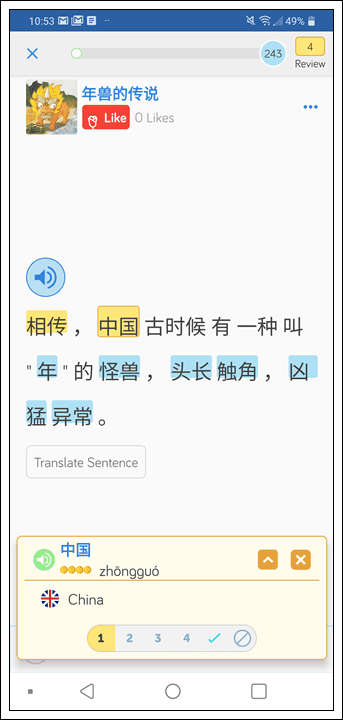5 Chinese Children Stories for Beginners
While learning to read Chinese can be a challenge, particularly if you’re unfamiliar with the written characters used by the language – reading Chinese children stories can ease the pain 🙂
Other than well-known children stories like 白雪公主 (Snow White) and 三只小猪 (The Three Little Pigs), there are lots of simple Chinese children stories for you to read and develop your Chinese reading skills. If you don’t know where to start, I’ve got good news. Below are 5 stories (some easy, some a little more advanced) that I recommend you to start with.
Chinese Children Stories
年兽的故事 / The Story of New Year Beast
There are many ancient stories that surround Chinese New Year but this is one of my favorites. 年兽的故事 is about a monster named 年 who would sift through villages every year and scare the locals. However, one particular year, a villager was wearing a red tunic which happened to startle 年. When 年 ran off, the same villager told the locals how his red tunic had scared monster. The locals and other villages began to setup red flags and firecrackers every Chinese New Year to scare away 年.
画蛇添足 / Draw a Snake and Add Feet to it
“Draw a snake and add feet to it” is a Chinese idiom which can also be interpreted as “less is more”.
楚国 有 个 贵族。
During the Chu dynasty, there was an aristocrat.
祭 过 祖宗 以后,他 把 一 壶 祭酒 赏 给 帮忙 的 仆人。
After worshiping the ancestors (on one day), he gave a jug of libation to the servants who helped him.
仆人 商量 说 “我们 都 来 画 蛇, 谁 先 画 好, 谁 就 喝 这 壶 酒”
The servants discussed among themselves and said, “Every servant would draw a snake in the ground. The man who finished first would drink the wine.”
有 一 个 人 很 快 把 蛇 画 好 了。
One man finished very quickly.
他 端 起 酒壶 正 要 喝,看到 别人 还 在 忙 着 画 蛇,就 得意 地 说:“我 能够 再 给 蛇 添 上 几 只 脚 呢”
He was about to drink the wine. However, when he saw others were still busy drawing, he said in triumph: “I can add feet to my snake.”
可是 没 等 他 把 脚 画 完, 另 一 个 人 已经 把 蛇 画 成 了。
However, before he finished drawing the feet, another man finished drawing a snake.
那 人 把 那 壶 酒 抢 过去,说: “蛇 本来 是 没有 脚 的,你 怎么 能 给 它 添 上 脚 呢”
That man grabbed the jar and said: “Who has ever seen a snake with feet? How do you add feet to it?”
说 完,便 把 壶 中 的 酒 喝 了 下去。
Then, he drank up the wine.
那个 给 蛇 画 脚 的 人 最终 没有 喝 到 酒。
The man who added feet to the snake didn’t get the wine in the end.
小白兔乖乖 / Little Rabbit
小白兔 乖乖, 把 门 开 开,快点 开 开,我 要 进来。
Little rabbit, hurry up and open the door, I want to come in.
不 开 不 开 不能 开,妈妈 没 回来,不能 把 门 开。
No, my mum is not back yet, so I can’t open it.
小白兔 乖乖, 把 门 开 开,妈妈 回来,我 要 进来。
Please open the door, my little rabbit. Mum will be back and I want to come in.
快 开 快 开 快快 开,妈妈 回来 了,我 来 把 门 开。
Hurry up and open the door, mum is back and I will open it.
狐狸与葡萄 / The Fox and the Grapes
Have you ever heard the phrase “吃不到葡萄说葡萄酸”? It literally means that when one cannot attain the grapes, they will respond by saying the grapes were too sour to eat anyway. This term is now often used by Chinese people to describe someone who lacks the capacity to complete something, defending their inability by saying it is not worth completing. This story is short and easy to comprehend – let’s have a look at it below!
一只 狐狸 发现了 一棵 葡萄 树,
The fox found a vine.
树 上 长 满 了 香 甜 的 葡萄。
The vine had many clusters of delicious grapes.
狐狸 看 着 葡萄,忍 不 住 用 舌头 舔着 嘴唇,
The fox looked at the grapes. He licked his lips with hunger.
心 想: “哇啊!是 好 食物 哩!”
“Wow! Such good food this is!” he thought.
它 向 上 跳 了 几次,却 总 是 够 不 到。
But though he jumped and jumped he couldn’t get any.
附近 的 小 动 物 都 在 笑 狐狸。
The nearby animals all laughed at the fox.
“哼! 这 些 葡萄 还 很 酸, 不能 吃 的!”
“Hum!” the fox muttered. “These grapes are still too sour to eat!”
狐狸 嘟 囔 着, 垂 头 丧 气 地 回家 了。
And so he went home dejectedly.
这 就是 吃不 到 葡萄 说 葡萄 酸 的 来历。
This is what is meant by the phrase “sour grapes.”
龟兔赛跑 / The Race Competition between Rabbit and Tortoise
You’ve probably heard of this story before. Well, here it is in Chinese:
为 了 赢 得 森林 音乐会 的 门票, 小 乌龟 决定 接受 小兔子 的 挑战,和 他 进行 一 次 赛跑。
To win a Forest Concert ticket, the tortoise accepted the rabbit’s challenge and joined the race.
比赛 的 路线 是 从 老虎 市长 的 办公室 门口 到 森林 花园 的。门口。 先 到达 终点 的 就 是 胜利者。
The race route is from the Major Tiger’s office to the woods garden and the one who finishes the race first is the winner.
所有 的 动物 们 都 看好 小 兔子,觉得他 一定 会 战胜 小 乌龟。
All animals believed the rabbit would be the winner.
小 兔子 飞快 跑 向 终点, 路上 没有 看到 小 乌龟 的 身影。他 心里 暗 暗 高兴, 心 想 小 乌龟肯定 还在后面慢慢着。
The rabbit ran fast to the destination and didn’t see the tortoise on the road. He was happy, thinking that the tortoise was crawling on the road.
可 当 小 兔子 转 过 身 时,发现 小 乌龟 已经 站 在 终点 了。
But when he turned around, he found the tortoise already arrived.

Learn Chinese Faster Using LingQ
Immersing yourself in Chinese doesn’t require you to travel abroad or sign up for an expensive language program.
However, it can be a bit tiresome to find interesting content, go back and forth between sites, use different dictionaries to look up words, and so on.
That’s why there’s LingQ. A language app that helps you discover and learn from content you love.
You can import videos, podcasts, and the stories that are mentioned above and turn them into interactive lessons.

Keep all your favorite Chinese content stored in one place, easily look up new words, save vocabulary, and review. Check out our guide to importing content into LingQ for more information.
LingQ is available for desktop as well as Android and iOS. Gain access to thousands of hours of audio and transcripts and begin your journey to fluency today.
Check out LingQ to discover how to learn Chinese!
***
Born in Hong Kong, Annie Law is fluent in Cantonese and Mandarin. She’s a reporter from 9-5 and a foodie 24/7 who’s proud to call Vancouver her home.

